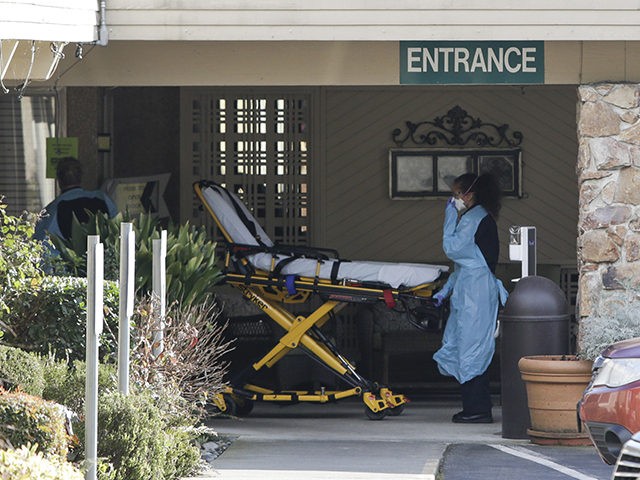The coronavirus infection fatality rate is lower than initially predicted, perhaps similar or even lower than the seasonal flu’s 0.1 percent for some segments of the population, a couple of doctors confirmed in testimony before a Senate panel on Thursday.
Breitbart News has highlighted some studies that took into account mild or asymptomatic infections and found that the ongoing pandemic is more widespread but less deadly than early estimates.
One of those studies placed the coronavirus illness’s (COVID-19) infection mortality rate as low as 0.1 percent, similar to that of the flu.
A death rate that takes into account the estimated number of mild or asymptomatic infections is known as the infection fatality rate.
At least two medical experts testified about the coronavirus infection mortality rate during a hearing held Thursday by the Republican-led Senate Committee on Homeland Security and Governmental Affairs on Thursday
In written testimony, Dr. Scott Atlas, a senior fellow at Stanford University’s Hoover Institution, said, seemingly referring to the infection death rate:
By now, multiple studies from Europe, Japan, and the US all suggest that the overall fatality rate is far lower than early estimates, perhaps below 0.1 to 0.4%, i.e., ten to forty times lower than estimates that motivated extreme isolation.
"Smart, safe re‐entry cannot be delayed by fear or hypothetical projections, because we have direct data on risk and experience with managing it. The goal of the strict isolation has been accomplished." 2/2
— Edwin Mora (@EdwinMora83) May 7, 2020
Echoing Atlas, Dr. John Ioannidis, a Stanford University professor of medicine, epidemiology, and population health, as well as of biomedical data science and statistics, explained the difference between “infection fatality rate” and “crude fatality rate” in his written testimony, noting:
Shelter-in-place and lockdown orders were justified initially, when announcements declared a new, contagious virus with 3.4% fatality rate and no asymptomatic infections. Prospects of 60 million deaths worldwide led to comparisons against 1918 influenza. However, currently we know that asymptomatic or mildly symptomatic infections are very common. The numbers of people infected are far more than those documented to-date with [the laboratory analysis technique known as] PCR [Polymerase Chain Reaction] testing. Infection fatality rate is accordingly much lower than the crude fatality rates derived from dividing the number of deaths by the number of documented [confirmed] cases.
…
The fatality rate from COVID-19 is highly dependent on age and modulated by the presence of [underlying medical issues]. For children and young adults, it appears that infection fatality rate is lower than seasonal influenza, and for middle age adults it is about the same.
Dr #Ioannidis to Senators: "For children and young adults, it appears that infection fatality rate is lower than seasonal influenza, and for middle-age adults it is about the same. … While lockdowns were justified initially, their perpetuation may risk many lives."
— Edwin Mora (@EdwinMora83) May 7, 2020
Dr. Ioannidis did warn of a potential second wave and a possible rise in the infection fatality rate among vulnerable segments of the population, namely people in nursing homes and on the frontlines of the battle against coronavirus.
He testified:
Of course, a second wave cannot yet be excluded. Its occurrence and potential magnitude can only be speculated with mathematical models, but models have not been very successful so far in COVID-19 predictions. Therefore, we need to proceed with caution in lifting lockdown and monitor the impact of any changes in policy measures with real data, as opposed to just using models.
…
Infection fatality rate can increase sharply, however, when nursing homes are massively infected and when unprepared hospitals are overwhelmed and the infection spreads to hospitalized patients (nosocomial infection). This explains the paradox why COVID-19 is typically a very mild, benign infection, but it also has the potential to become devastating in specific settings.
Not all witnesses agreed that the infection fatality rate was similar or lower to the flu’s 0.1 percent.
Dr. Tom Inglesby, the director of the Center for Health Security at Johns Hopkins Bloomberg School of Public Health, testified that the infection fatality rate is higher than the flu’s, noting in his written testimony:
Most studies that have been done calculate the infected fatality rate to be in the .5 to 1% range. For example, this Lancet analysis concluded that there was an infected fatality rate of .66% in China. If .5% of 233 million people were to die from this illness in the US, that would be 1,165,000 deaths.
Dr. Inglesby also appeared to disagree with the assessment by Atlas and Ioannidis that lockdowns have achieved their intended purpose.
Atlas, the former chief of neuroradiology at the Stanford University Medical Center, told Senators:
We also know that total isolation prevents broad population immunity and prolongs the problem. … Smart, safe re‐entry cannot be delayed by fear or hypothetical projections, because we have direct data on risk and experience with managing it. The goal of the strict isolation has been accomplished.
Dr. Ioannidis added:
While lockdowns were justified initially, their perpetuation may risk many lives. Mental health can be affected with increases in depression, suicides, domestic violence and child abuse. Gun sales have increased. Famine is becoming a global threat.
Meanwhile, Dr. Inglesby spoke against allowing the disease to spread relatively unencumbered until the population achieves “herd immunity,” an approach followed by Sweden.
Inglesby testified:
Epidemiological estimates are that it will require on the order of 70% of the population to be infected to achieve herd immunity. 70% of the US population is about people 233 million people. … It is likely that the infected mortality rate would go up substantially under conditions where the virus were allowed to spread rapidly in the US with no social distancing.
Inglesby’s colleague, Johns Hopkins University epidemiologist Caitlin Rivers told a Democrat-led House Appropriations Subcommittee on Wednesday that not one U.S. state should be reopening at this time.

COMMENTS
Please let us know if you're having issues with commenting.